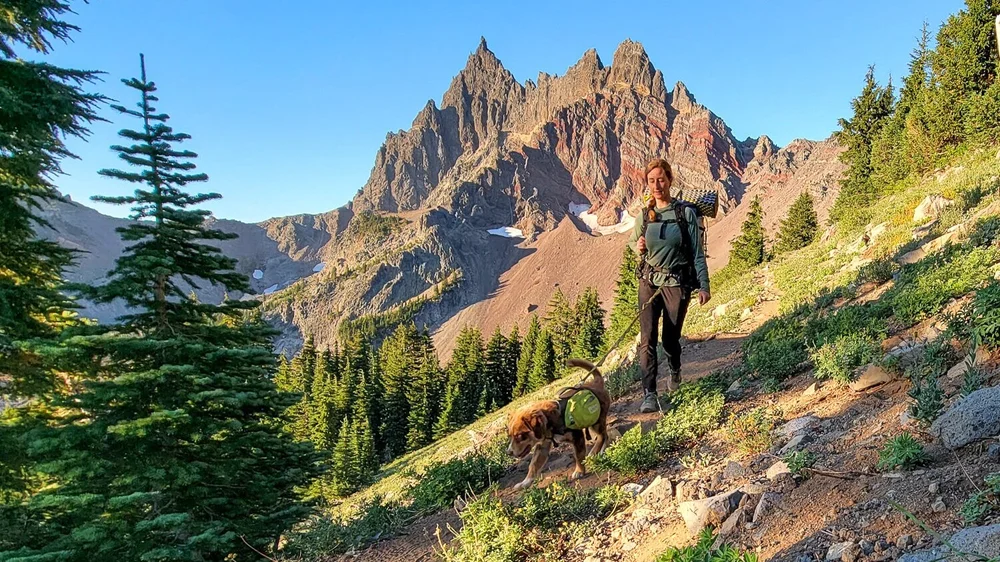
This moderately easy and short loop route around Three Fingered Jack offers nearly unending mountain and lake views. You’ll not only get up close and personal with craggy Three Fingered Jack as you circumnavigate the peak, but you’ll also catch glimpses of the surrounding Cascade Range volcanoes around every corner. Over half of the route coincides with the Pacific Crest National Scenic Trail, which tends to be well-graded and maintained. And since it’s less than 24 miles, this trip is doable in just a couple of days.
The majority of the trail traverses land that was ravaged by the B&B Complex Wildfire in 2005. The lack of tree cover lends itself to intense exposure at times, but the stands of white ghost trees are eerie and strikingly beautiful in their own right. The openness due to the lack of brush also makes it possible to see distant views of Mt. Washington, Jefferson, and the Three Sisters for much of the way.

There’s no shortage of views on the Three Fingered Jack Loop - this view is of Wasco Lake from Minto Pass
Quick Facts
Distance: 20.9-23.7
Days Needed: 2-3
Type: Loop
Elevation Gain/Loss: 3,651 ft.
Best Travel Time: Late July-September
Difficulty: Moderate
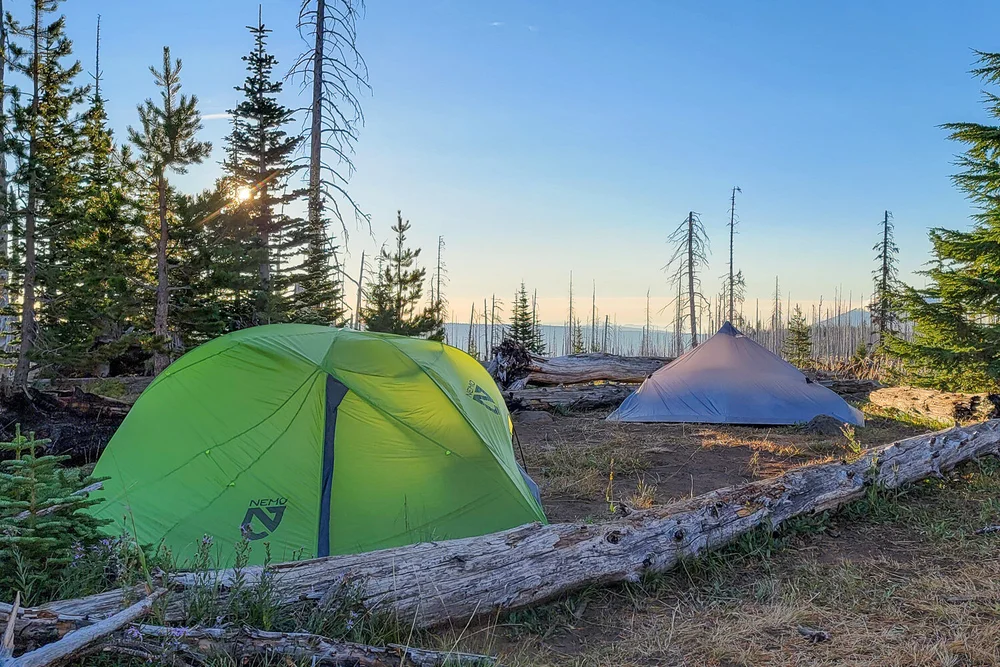
The trail is open from June to October, but we like it best in late summer through fall
Highlights
Easy terrain with gradual climbs/descents
Closeup views of Three Fingered Jack
Distant views of Mt. Washington, Mt. Jefferson, and the Three Sisters
Wildflowers
Glimmering trout-filled lakes
Abundant huckleberries in July and August
Dog friendly (on leash)

The openness due to the lack of brush makes it possible to see distant views of Cascade Mountains like Mt. Jefferson
Lowlights
Exposure (sun and wind can be intense from lack of tree cover)
East side of the loop is brushy (manzanita)
Substantial blow-downs
Mosquitos in June and July
No on-trail water sources on the PCT side (8.5 miles)
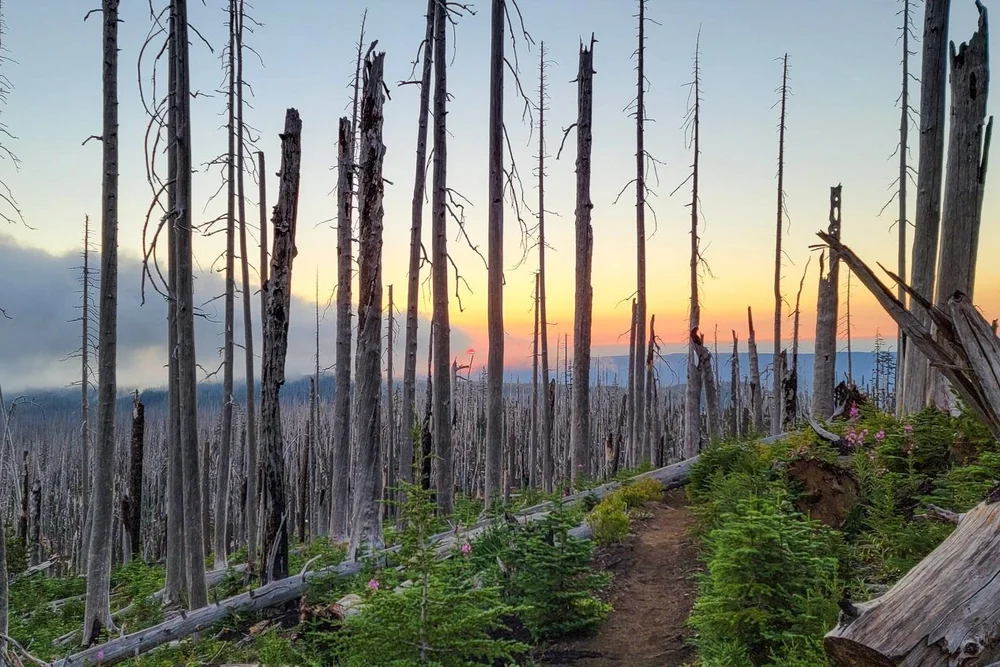
Most of the route is in a burn area - the stands of white ghost trees are eerie and strikingly beautiful
Best time to travel
The Three Fingered Jack Loop is accessible June through October. However, this is lake country and the bugs can be pretty heinous during the earlier part of the summer. To avoid the worst of the mosquitoes, hike in early August and September. You’ll also be able to graze on ripe huckleberries along the NW part of the loop during these months. That said, the peak of wildflower season is in July. If you decide to hike then, we recommend treating your clothes with permethrin and using Picaridin on your skin to prevent bites. Learn more on our Mosquitos & Hiking: How to Protect Yourself post.
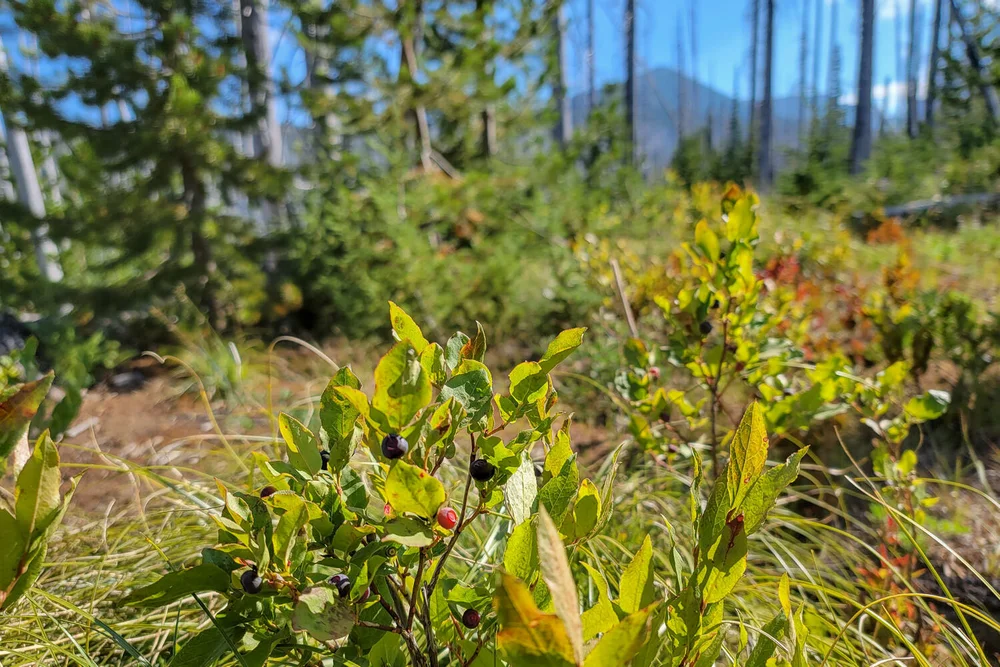
Huckleberries are abundant along the trail in late July and early August
Difficulty
This route is well-graded and has few big climbs or descents. If you’re a strong hiker and you split the mileage up over two or three days, you can take it slow and have plenty of time to relax in camp. Overall, we found this trail to be moderately easy. That said, the exposure from lack of tree cover presents a unique set of challenges. Start early to beat the heat if you can, and wear protective clothing or sunscreen, a hat, and sunglasses since you’ll be in the direct sun most of the day. Strong evening winds are notorious on the east side of the trail, so make sure you have a warm jacket, a solid shelter with stakes and guylines, and a stove that performs well in challenging conditions.
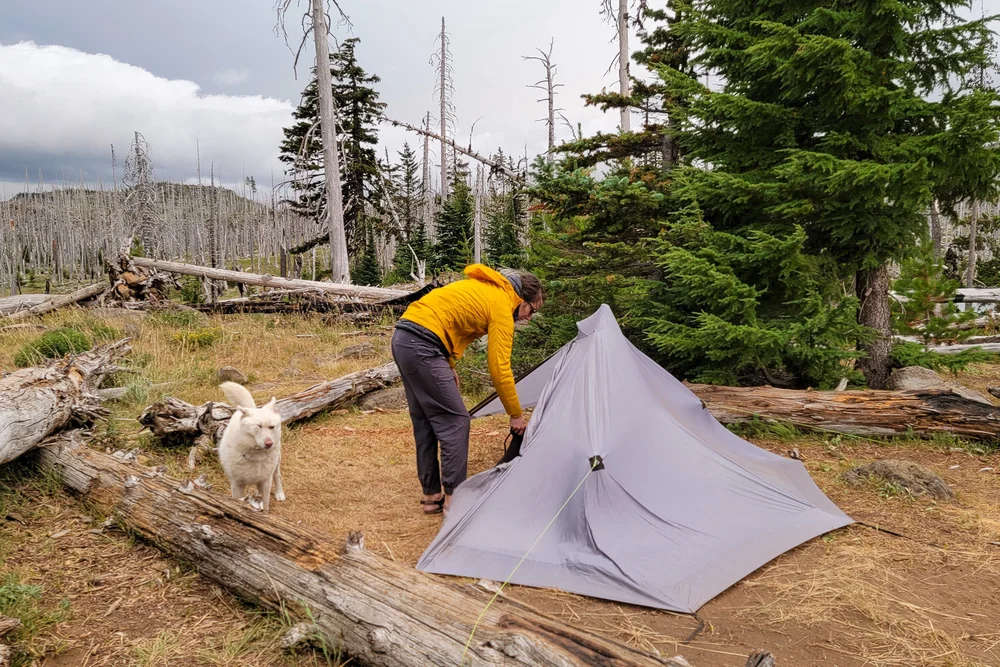
Winds can be strong on the east side of the trail - we got hammered with high winds blowing fine dirt near Booth Lake
Permits
The popularity of the Mt. Jefferson, Mt. Washington, and Three Sisters Wilderness areas has exploded in recent years. In an effort to help mitigate the impact of trail users, the Forest Service has implemented a permit system. You’ll need a Central Cascades Wilderness Overnight Permit to hike the Three Fingered Jack Loop between May 28 and September 24.
The easiest and fastest way to get permits is through recreation.gov. Enter your desired start date in the ‘Available Permits’ box in the upper right corner, then hit the ‘Check Availability’ button. Choose ‘Mt. Jefferson’ when you’re prompted to choose a starting area, then scroll down to ‘PCT Santiam’ to see which dates have openings. Central Cascades Wilderness Overnight Permits can be reserved a full season in advance or seven days in advance.
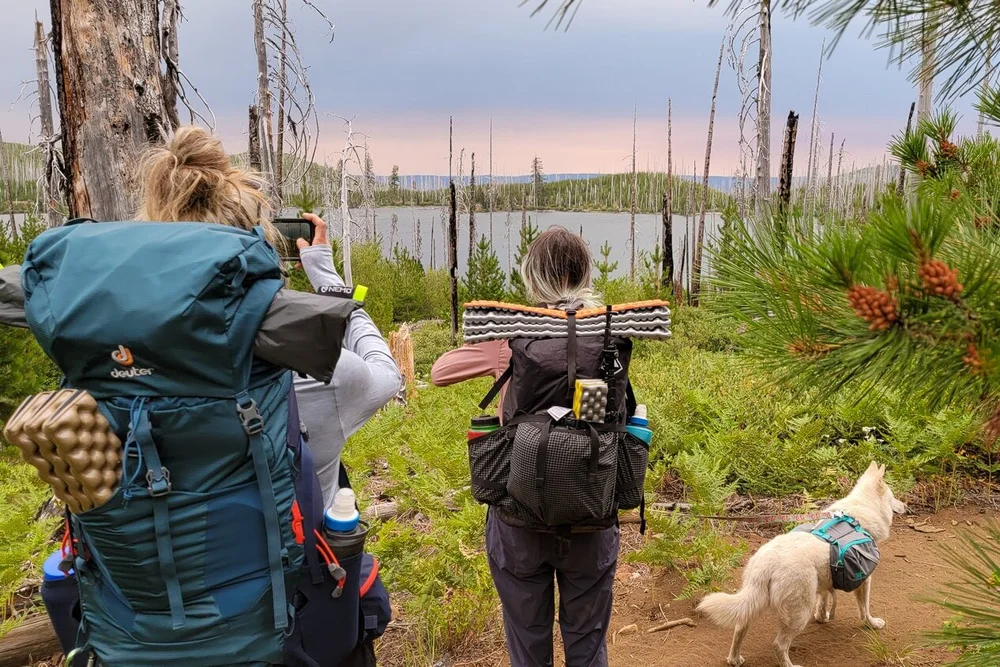
Permits are cheap & easy to get, but you’ll have to plan ahead a little to get the start date you want
Getting There
The most popular starting point for the Three Fingered Jack Loop is the Pacific Crest Trail - Santiam Pass trailhead. It’s located in Central Oregon near Camp Sherman. The closest full-service town is Sisters, OR. You can hike the loop in either direction, starting at the south end near Highway 20. Take the PCT #2000 to hike the dry, but more scenic west side first, or turn right at Summit Trail #4041 to hike from lake to lake along the east side. Alternatively, you can access the northeast part of the route via the Jack Lake trailhead. The road to Jack Lake trailhead is long and windy so a high clearance vehicle is recommended, though there are often sedans in this popular lot on weekends.

The most dramatic views are along the PCT, but we also enjoyed views of Mt. Washington & many lakes along the east leg
Maps
It’s always a good idea to carry a paper map and compass on backcountry trips. The Trails Illustrated Mount Jefferson and Mount Washington Topographic Map covers this hike, plus a lot more in the area.
We also love using GPS phone apps, like Topo Maps+ (Apple only), Gaia GPS, and Avenza Maps so we can easily plan around campsites and water sources, track our mileage, and record notes for future reference. Check out our How to Use Your Phone as a GPS Device for Backpacking post for some tips if you’ve never used a navigation app before. We downloaded the 819 Mount Jefferson, Mount Washington Avenza Map bundle for this hike. The east side map showed the area in plenty of detail for our purposes. If you plan to do any climbing on Three Fingered Jack, you’ll want a more detailed climber’s map.

We used a combo of the Trails Illustrated Mount Jefferson and Mount Washington Topographic Map & Avenza
Regulations
The Mt. Jefferson Wilderness is a special area that requires a Central Cascade Wilderness Permit for overnight use and some day use between May 28 and September 24. Outside this time frame, you’ll just need to fill out a free, self-issued wilderness visitor use permit at the trailhead.
As always, you should practice 'Leave No Trace' techniques in Wilderness areas, including properly disposing of human and pet waste and carrying out all trash.
Fire danger is generally high during the hiking season in this area. Check the Forest Service Fire page to check on wildfire conditions and burn bans before you go. It’s common for campfires, alcohol stoves, and wood-fueled camp stoves to be prohibited. Backpacking stoves and lanterns using liquefied or bottled fuel are still allowed as they can be instantly switched off.
No groups over 12 people.
No hitching or tethering pack animals within 200 feet of any permanent lake, stream, spring, pond or shelter.
No motorized equipment and mechanized equipment such as bicycles, wagons, carts or wheelbarrows (except wheelchairs).
No flying drones or unmanned aircraft systems.
No discharging a firearm within 150 yards of a campsite or occupied area or across a body of water.
No camping or being within areas posted as closed for rehabilitation.
No cutting or damaging any live tree or vegetation unless authorized.
No storing equipment, personal property or supplies within the wilderness for more than 48 hours.
No gathering a forest product, for example mushrooms and berries, except for personal on site use.
No commercial use and/or services within wilderness except by special use permit.

Thick manzanita brush lines most of the Old Summit Trail - we recommend wearing pants to protect your legs
Water
There’s plenty of water on the east side of the Three Fingered Jack Loop (Old Summit Trail), but there are no reliable water sources on the PCT between Santiam Pass and Koko Lake (about 8.5 miles). Most people opt to cover the dry stretch in one day so that they don’t have to dry camp. That said, there are some really beautiful campsites along the PCT. If you’re willing to “camel up” and carry enough water for drinking and meals, it could be well worth the effort. Since most of the water sources along this route are lakes, make sure you have a reliable water filtration system. For this trip, our party used the Platypus QuickDraw Microfilter System and the Katadyn BeFree along with Smartwater bottles. A couple Platypus SoftBottles came in handy for carrying extra water on the dry stretch.

The Platypus QuickDraw Microfilter System & Smartwater bottles are convenient for filtering water from lakes
Hiking with Dogs
Dogs are allowed on the Three Fingered Jack Loop, but they have to be kept on a leash. There is quite a bit of blow down on the Northern section of the route, so it’s helpful if your dog knows some basic commands like ‘up’, ‘under’, and ‘wait’ so you can navigate the fallen logs together.
Since this trail is very exposed, it’s also easy for dogs to overheat. They don’t sweat like we do, so take precautions to keep them cool - offer water frequently and let them rest in the shade when they need to. If you can, start hiking early so you can avoid the heat. Also, pay close attention to your dog’s paws. Parts of the Three Fingered Jack Loop are volcanic (rocky and abrasive) and sandy (gets very hot). Hiking boots and/or Musher’s Wax will keep the paws from burning or collecting blister-causing debris. To learn more and see our Dog Gear Checklist, check out our 14 Tips for Hiking & Backpacking with a Dog post. We also have a Best Dog Backpacks list.

TIMBER IS WEARING THE OUTWARD HOUND DAYPAK without much in it for her first backpacking trip
Backpacking Gear: What to Pack
We prefer lightweight backpacking because it’s more comfortable and it allows us to cover more ground with less effort. For recommendations on our favorite lightweight backpacking equipment, check out the CleverHiker Gear Guide and our Top Picks page.
TENT: We used the Sea to Summit Telos TR2 on this trip. We love this tent for its great balance of livable space and low weight. It performs very well in the wind and is very easy to set up, even in challenging conditions. The Telos TR2 is on our list of the Best Backpacking Tents. You’ll also need plenty of stakes and guylines since this loop can be windy on the east side.

The Sea to Summit Telos TR2 holds up well in high winds & feels spacious for a single hiker with a dog, & gear
SLEEPING BAG: We took the Kelty Cosmic Down 20 on this trip. It’s affordable, durable, and plenty warm for summer nights, which is why it’s on our list of the Best Sleeping Bags.

The Kelty Cosmic Down 20 is affordable & durable so it’s a great choice for backpacking with a furry companion
SLEEPING PAD: We used the Therm-A-Rest NeoAir UberLite on this trip since nightime temperatures were well above freezing and this pad is comfortable, compact, and ridiculously ultralight. The UberLite is one of the top picks on our list of the Best Backpacking Sleeping Pads.
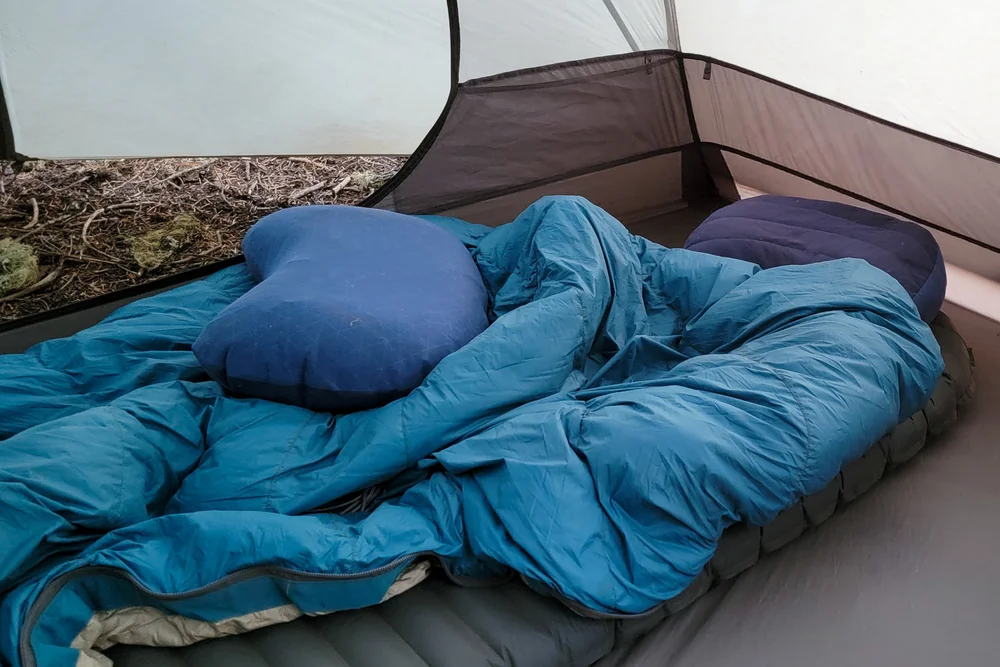
The Therm-A-Rest NeoAir UberLite sleeping pad is so lightweight, you can carry some luxuries (we brought two pillows!)
BACKPACK: We chose the ULA Circuit for this trail. It’s lightweight, but durable and has a ton of useful features including huge hip belt pockets to stash small items. Check out our list of the Best Backpacking Packs for our top backpack recommendations.

The ULA Circuit backpack is designedby thru-hikers, so it’s really dialed in for everyday needs on the trail
COOKING SYSTEM: We used the MSR Pocket Rocket 2 Stove Kit for this trip, which includes one of our all-time favorite stoves, a pot with lid, a cup, and a pot grip all in an ultralight, compact package. The Pocket Rocket 2 is a top pick on our Best Backpacking Stoves list.

The MSR Pocket Rocket 2 Stove Kit has everything a solo hiker needs for ultralight backpacking
FOOD: Since this trip is fairly short, you don’t have to carry a heavy load of food, and you can afford to take along some extra luxuries if you’d like. Check out our guides on the Best Lightweight Backpacking Food, Best Freeze Dried Backpacking Meals, and Best Energy Bars for some of our go-to recommendations.
FOOD STORAGE: Bear canisters aren’t required on the Three Fingered Jack Loop, but it’s always a good idea to store your food properly for peace of mind. We used an Ursack to keep rodents from getting their paws on our goods at night.

Freeze Dried Backpacking Meals are lightweight, onvenient, & quick
WATER FILTER: We took the Katadyn BeFree and Platypus QuickDraw Microfilter System on this trip, because they’re lightweight, convenient, and easy to use on the go. Check them out on our list of the Best Backpacking Water Filters.
WATER BOTTLES: We like using the BeFree in combination with the Hydrapak Flux Bottle because it’s easy to squeeze and collapses when not in use. We use Smartwater bottles with other filters since they’re super lightweight and fit in backpack pockets well. When we need more storage, a Platypus SoftBottle or two can be a lifesaver. Head over to our Best Water Bottles list to read more about our favorite bottles for backpacking.

The Platypus QuickDraw Microfilter System with Smartwater bottles & a Platypus SoftBottle for dry camping
SHOES OR BOOTS: We wore the Saucony Peregrine 11 hiking shoes for this hike. They’re lightweight, breathable, and comfortable, so our feet never felt hot or stuffy and we didn’t get a single blister. The Peregrines are on our lists of the Best Hiking Shoes and the Best Trail Running Shoes.

The Saucony Peregrine 11 hiking shoes are lightweight & comfortable so your feet can stay cool & blister-free
CLOTHING: Here are some of the clothing items we used on this trip in the summer. See more of our favorite hiking/backpacking clothing in our Gear Guides.
1 Down jacket - REI Magma 850 Down Hoodie 2.0 Men’s / Women’s
1 Pair hiking pants - Columbia Anytime Outdoor (Women’s)
1 Pair shorts - BALEAF Women's 3" Running Athletic Shorts
2-3 Pair socks - Feetures Elite Ultra Light Quarter
1 Sun hat - Flexfit Delta Seamless Cap
1 Pair gloves - Patagonia Capilene Midweight Liner
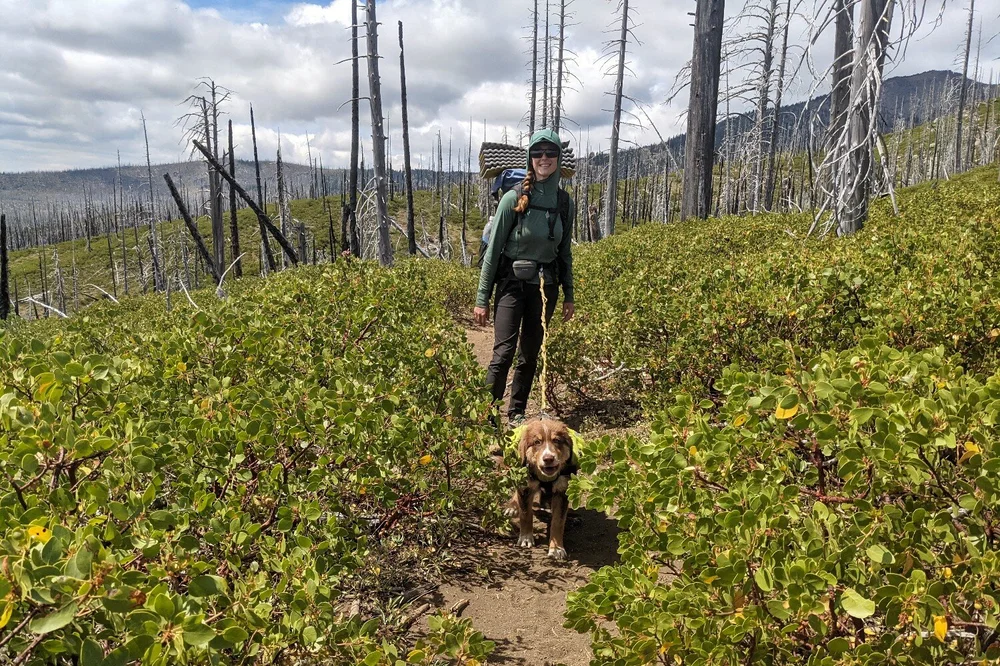
Clothing is a personal choice, but in general we prefer clothes that are lightweight, breathable, & easy to layer
CAMPING CHAIR: We prefer a simple sit pad like the Therm-a-Rest Z-Seat for ultralight backpacking trips, but there are plenty of options with more support if you want to up the comfort for this leisurely hike. Check out our list of the Best Backpacking Chairs.
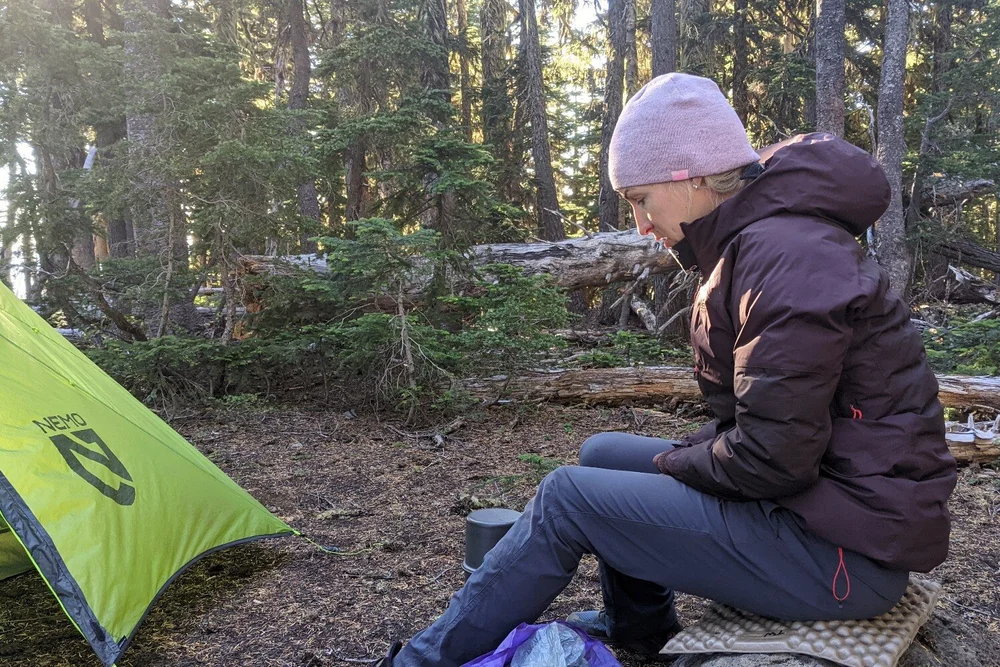
The Therm-a-Rest Z-Seat isn’t exactly a chair, but it keeps your pants clean & insulates you from the ground
HEADLAMP: We took the Black Diamond Spot 350 from our list of the Best Headlamps. It’s bright, reliable, and it’s a great value for the money. It also has some really handy features like a battery level indicator, lock, dimmer, and red light for night use.

The Black Diamond Spot 350 Headlamp is a great value with practical bells & whistles we appreciate
MAP & COMPASS: We used the Avenza phone app. for this trip and downloaded the 819 Mount Jefferson, Mount Washington Avenza Map bundle before we left home. In addition, we always hike with a paper map (Trails Illustrated Mount Jefferson and Mount Washington Topographic Map) and a compass.
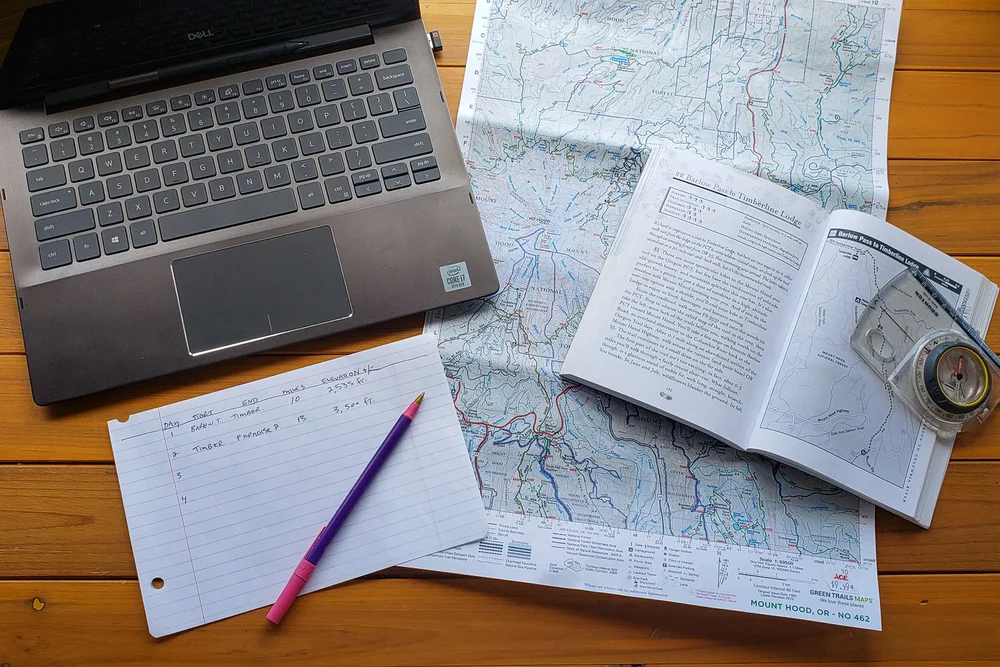
We downloaded the 819 Mount Jefferson, Mount Washington Avenza Map bundle & carried a paper map for this trip
MULTITOOL: We brought the Victorinox Swiss Army Classic SD on this trip. It’s affordable, super handy, and weighs less than an ounce.
FIRST AID KIT: Always bring a small personalized first aid kit; we used the .5 Adventure Medical Kit.
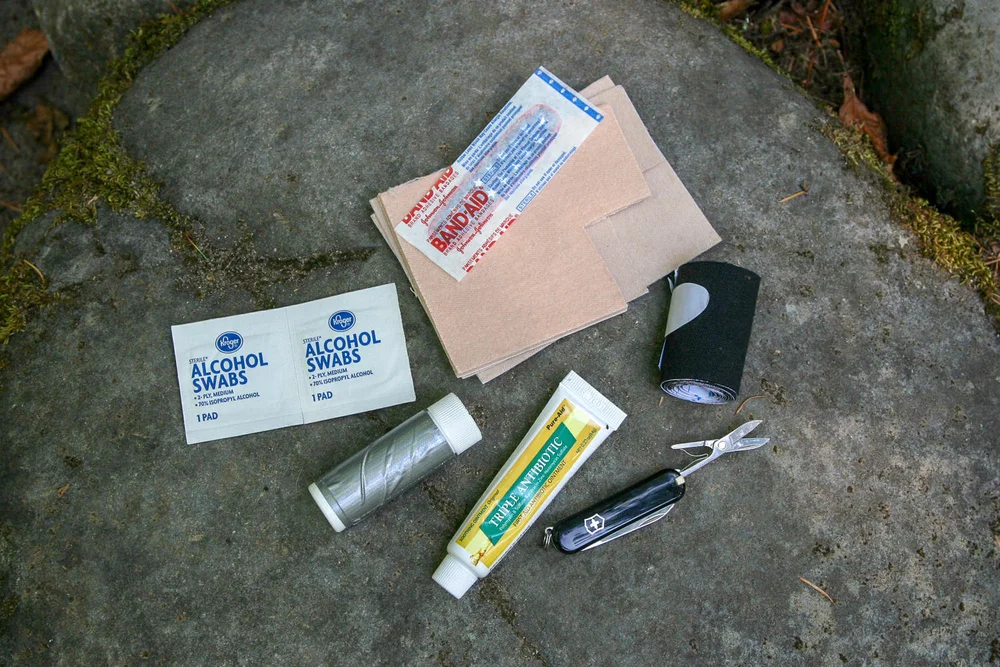
The keychain-size Victorinox Swiss Army Classic SD weighs almost nothing & comes in handy more often than you’d think
SUN PROTECTION: Sun exposure can be intense on the Three Fingered Jack Loop since most of it is in a burn area. Sunglasses (polarized recommended), sunscreen, and SPF lip balm are a must. We’re also big fans of sun shirts for trails like this. The Outdoor Research Echo Hoodie (men’s / women’s) is one of our favorites since it’s super breathable and has full coverage for your neck.

The Outdoor Research Echo Hoodie Men’s / Women’s protects your whole upper half much better than sunscreen alone
OTHER ITEMS:
Cash and ID
Personal toiletries
Hand sanitizer
Wet wipes
Insect repellant: a 1 oz. bottle of Picaridin will do the trick
Camera: the Sony Rx100 is our go-to camera for lightweight backpacking
Power bank - we like the Goal Zero Flip 24
You might also like our Ultimate Backpacking Checklist to help make packing for your next trip a breeze.
Three Fingered Jack Loop Photo Gallery
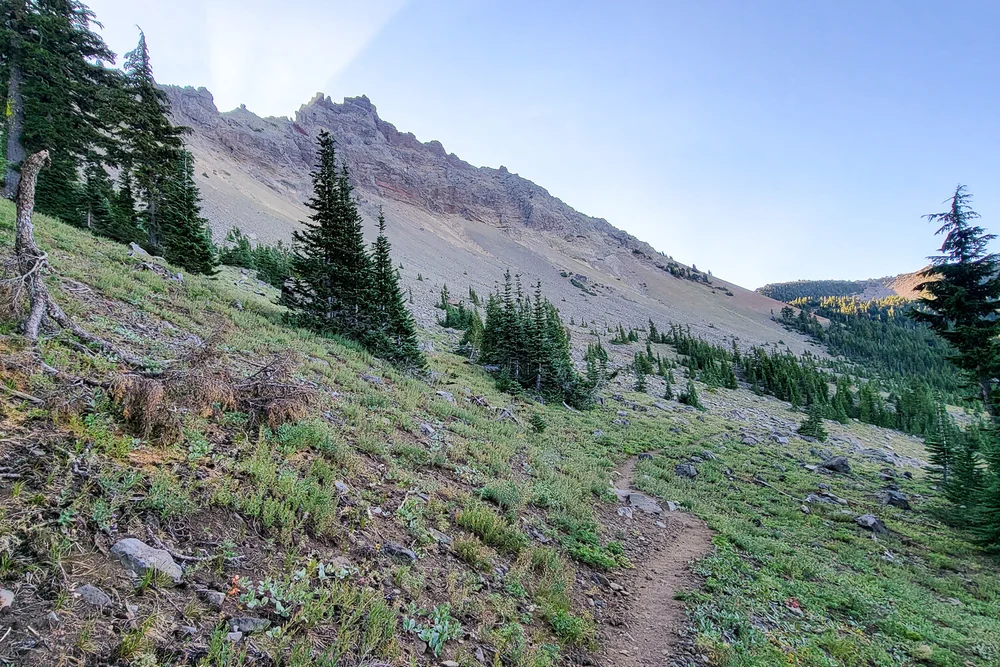
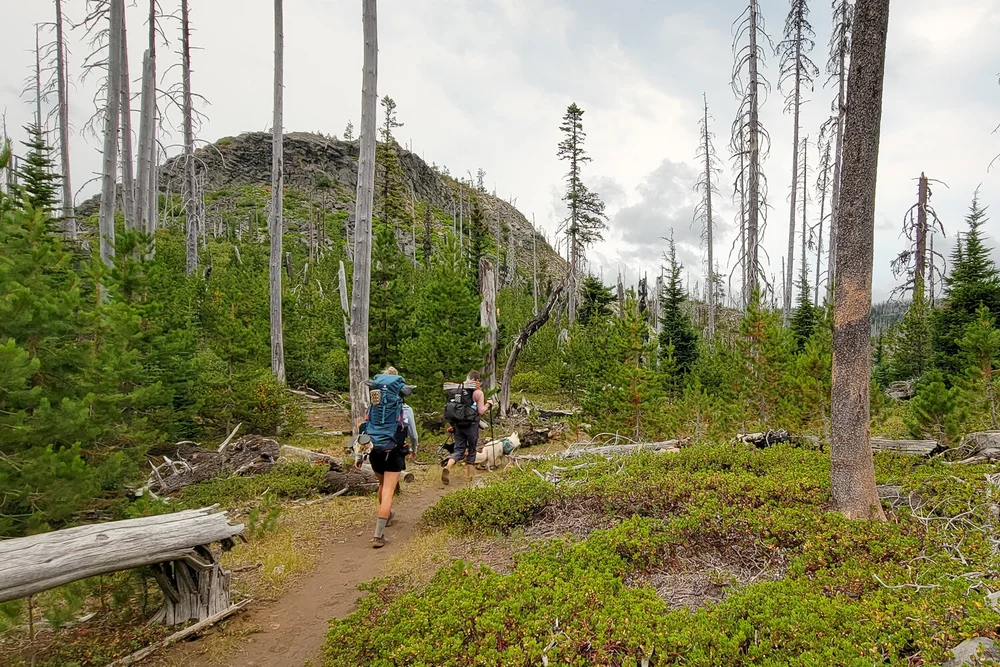
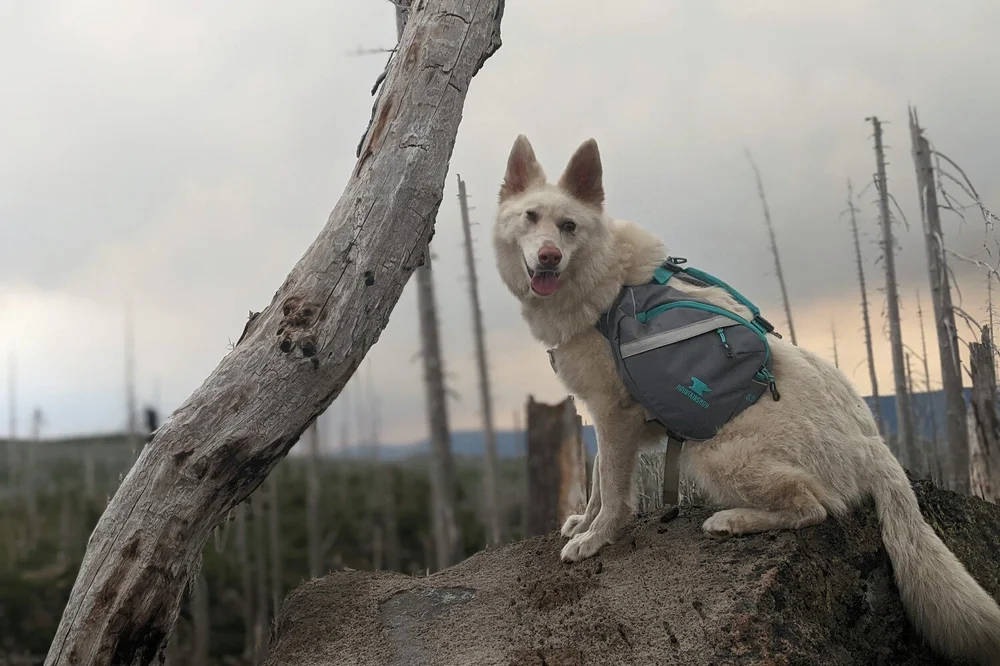
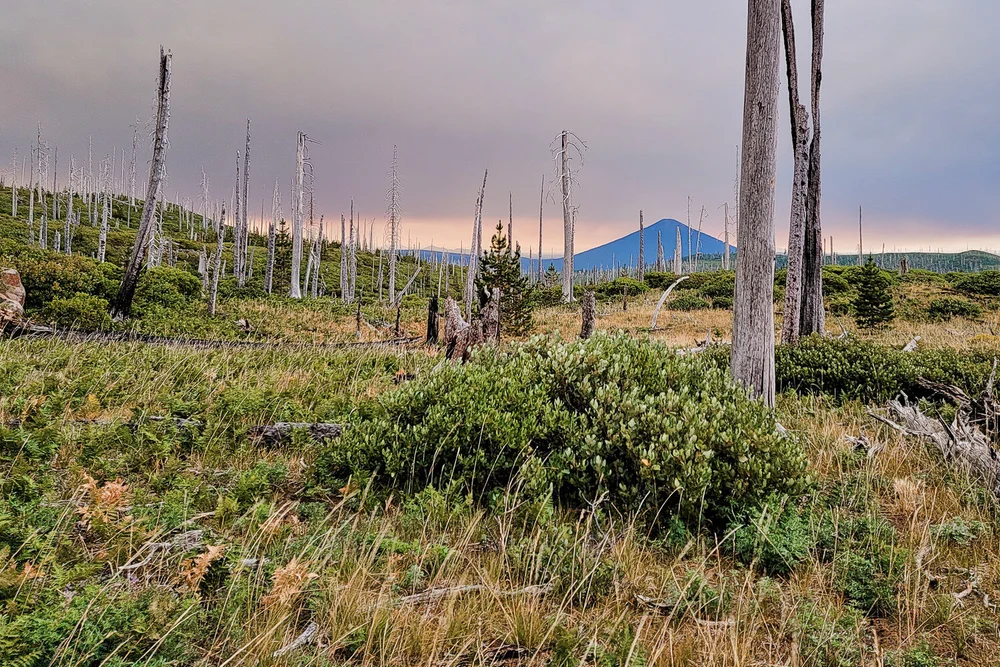
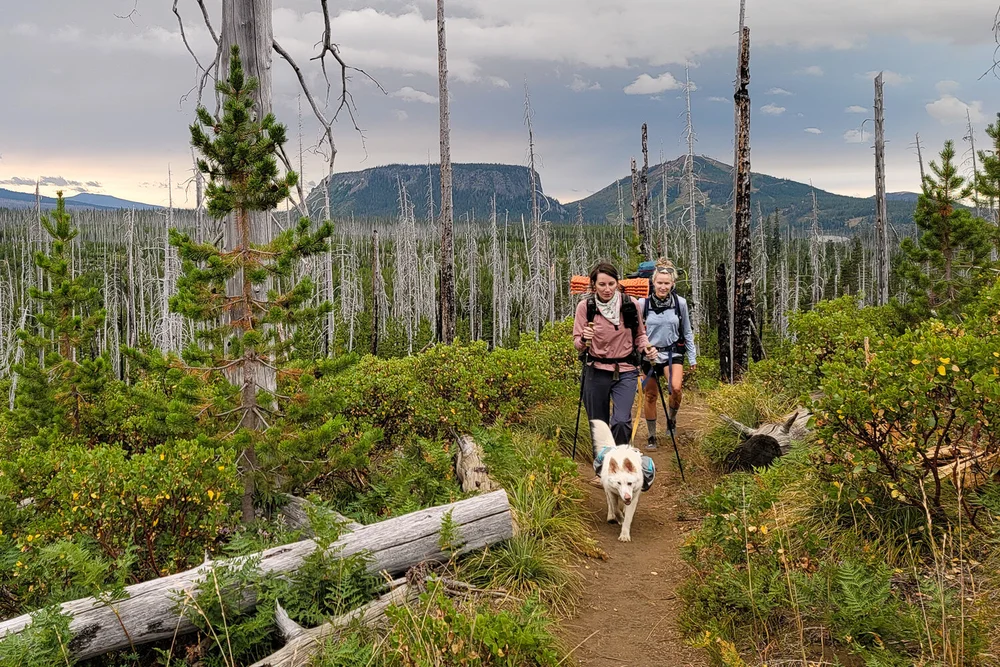



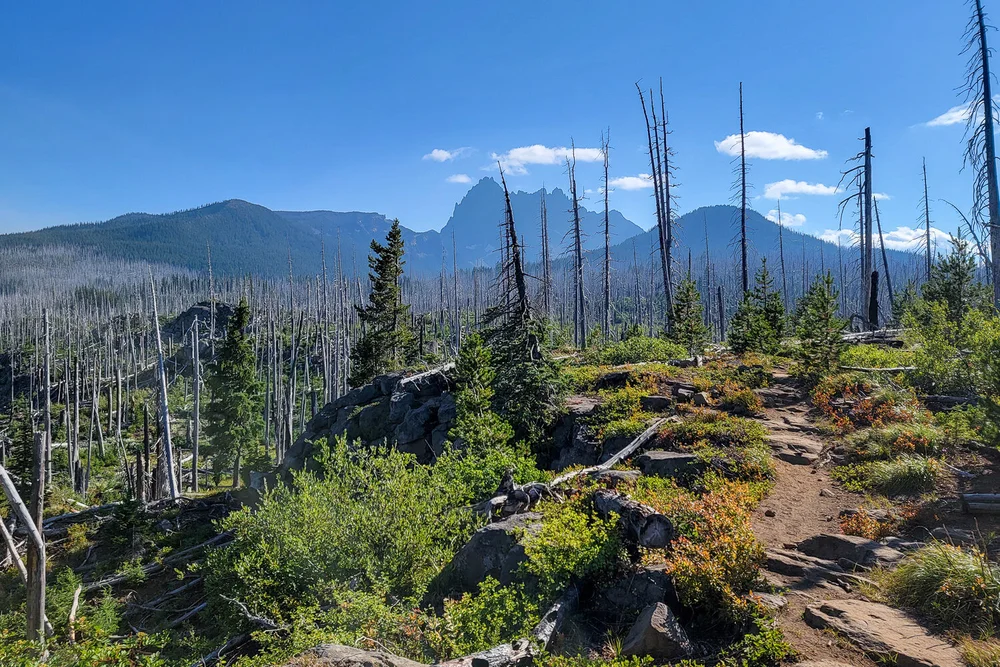

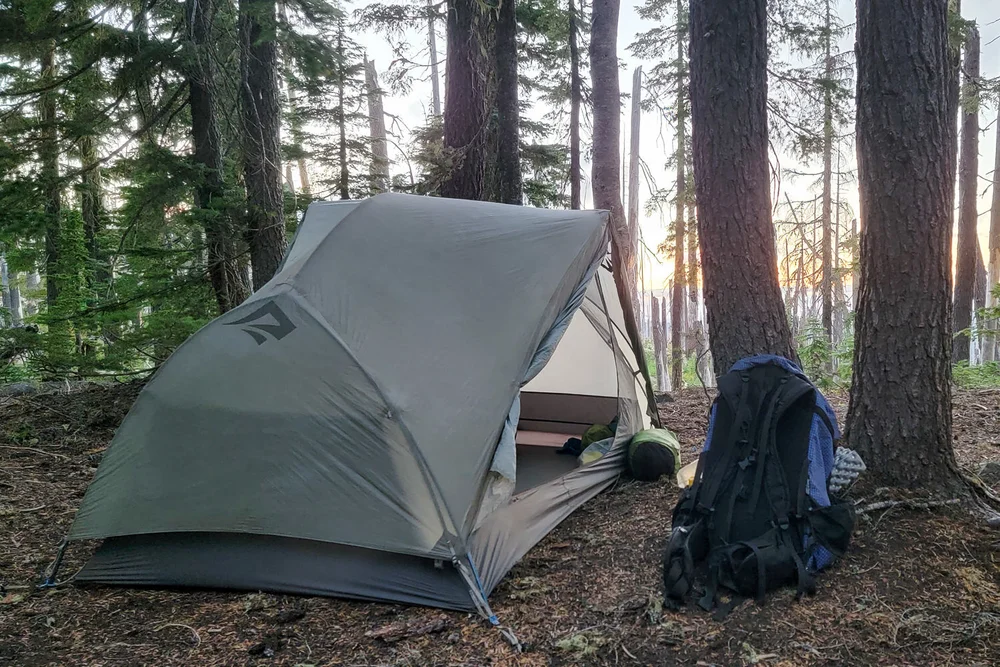



Some of the links on this page are affiliate links, which means we may receive a modest commission if purchases are made through those links. This adds no cost to our readers and helps us keep our site up and running. Our reputation is our most important asset, which is why we only provide completely honest and unbiased recommendations.